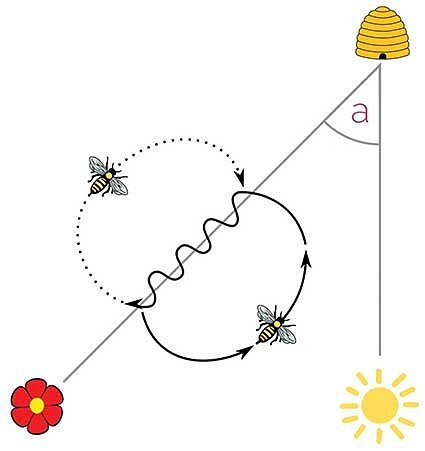
Wiggle Waggling their way to food...
This is the first part of a two part look at the ability of bees to communicate information. The second part will show how bees play their part in ensuring the efficiency of the Internet Cloud.Forager bees, representing about 12% to 15% of a colony, need to efficiently find sources of nectar (carbohydrate) or pollen (protein) and water, needed to nourish their whole colony that could be 40,000 strong.
It is important understand that a swarm of bees function collectively as a single organism consisting of four basic components:
• Queen - equipped to produce sufficient numbers of workers needed for changes the colony has to 'weather' through seasons of lean and plenty, hot and cold.
• Female workers - 'graduate' through all the work stages, needed in the hive, to support their colony.
• Male Drones - inseminate queen bees that are not from their own colony thus ensuring DNA diversity.
• Wax comb - forms the skeleton upon which the colony builds its reproductive womb and food storage areas.
The queen, with a life span of 3 to 4 years, remains in the hive during this time and is capable of laying as many as 2000 eggs a day. Female workers are regarded as cells of the single organism with a typical life span of 6 to 8 weeks depending upon work load stresses. Drones, contribute no food to the colony consuming instead hard won food brought back by the female foragers and are thus expendable, if conditions warrant this, such as during a dearth (no forage available) or cold period.
A colony is able to cover a large area during the course of its foraging bees sourcing food. They are easily able fly in a 2km to 3km radius from their hive, if needed, but prefer not to do so as long flights consume more of their precious resources and places greater strain and stress on them.
Each colony has scout bees constantly searching for new food sources. These move about randomly within the foraging area around the hive, to determine whether a new source is superior or inferior to those currently being exploited. If the source is superior they return to the hive to communicate this to the foragers by performing, in an area of the hive, a routine known as the ' Wiggle Waggle dance.' The dance pattern consists of a straight line, at an angle and a number of circles or a figure eight.
If the source is nearer than about 10 meters the pattern is a circle repeated to indicate distance – less repeats equals greater distance. The dance for distances beyond 10m to 100m are a combination of the circular pattern and one that resembles two semi-circles, side by side. The number of completed routines again indicating distance – 9 to 10 repeats for +/-100m while 4 indicates +/-1500m.
The last dance component to understand is the straight line and angle that it is given during the Wiggle Waggle routine.
The forager bees know precisely where the sun is, at any given time during the day, even if obscured by clouds. Using this knowledge provides a fixed reference point - fixed for all intents and purposes for the short duration of the flight. Forager bees emerging from the almost dark hive will head off at the angle - a - communicated, which is an angle to the sun, and fly directly to the food source after ensuring that they have sufficient fuel 'on board' to safely make the journey.
Thus the distance indicated by the Wiggle Waggle dance is as vital as is the angle that needs to be navigated if efficient exploitation of the new source is to be ensured and brought back to the waiting cells in the combs of the hive.
Lastly, the quality of the food source is communicated by the degree of excitement that the dancing scout bee exhibits with more excitement indicating superior quality.
In the instance of indecision as to the quality of the new source versus current supply, onlooking bees may request a sample from the scout performing the Wiggle Waggle dance, emitting a short squeak by thrumming the comb which causes the dancing bee to stop and dole out a sample. Doling out samples is vitally important for recruiting the foragers, who need to be convinced to change their current flight arrangement. to the superior source

